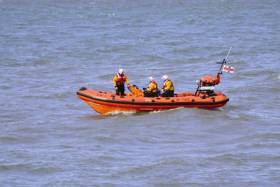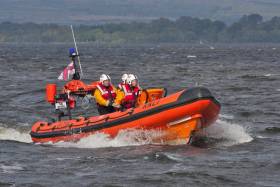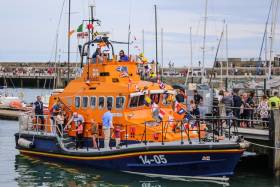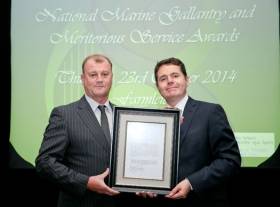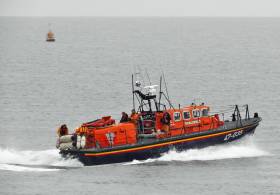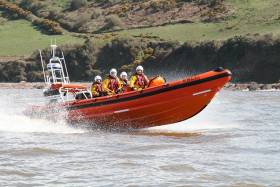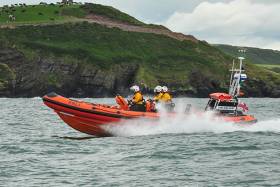Displaying items by tag: RNLI
Helvick Head Lifeboat Crew Rescue Man From Water After Pier Car Crash
#RNLI - Helvick Head RNLI rescued a man who got into difficulty in the water at Helvick Pier early this morning (Sunday 11 September).
The volunteer lifeboat crew was requested to launch their inshore lifeboat at 7.12am following a report of a potential tragedy at Helvick Pier on the Co Waterford headland.
On arriving at the car park, the crew observed a crashed car. The lifeboat took to the water immediately and within seconds shore helpers spotted a casualty in the water.
Once on scene with the casualty, crew members Shane Breathnach and Dónal Ó Faoláin entered the water to assist.
The casualty, who was struggling to stay afloat, was helped into the lifeboat where he was treated for hyperthermia by helm Shay Young and crew member Cathal Reilly.
The man was then returned to Helvick Lifeboat Station where he was cared for until the ambulance arrived and he was transferred to hospital.
"It was a close call this morning and we would like to commend local fishermen Barty Whelan and Richard Tobin who were active on the shore in raising the alarm, spotting the casualty and remaining on site," said Young following the callout.
"Once on scene, it took all four of us aboard the lifeboat to bring the man in and do what was necessary. We would like to wish the casualty a full recovery following his ordeal."
Wicklow Lifeboat Assists Yacht In Early Morning Callout
#RNLI - Wicklow RNLI's all-weather lifeboat launched at 5.32am yesterday morning (Wednesday 7 September) after the Irish Coast Guard received a call for assistance from a yacht in difficulties off the Wicklow coast.
The 10m British ketch, with two people on board, was on passage from Cornwall to Scotland when it developed steering problems, and its crew were having difficulty maintaining their course.
The lifeboat crew located the vessel in fog eight miles east of Wicklow Harbour at 6.10am. Conditions in the area had a southwest Force 3 with moderate sea and poor visibility.
The yacht was taken in tow back to Wicklow Harbour and was secured safely alongside the south quay at 7.45am.
Lough Derg Lifeboat Assists Fisherman On Boat Wedged In Rocky Shoal
#RNLI - Lough Derg RNLI was requested to launch by Valentia Coast Guard yesterday evening (Sunday 4 September) to assist a fisherman whose boat was wedged inside a rocky shoal.
At 5.50pm, the inshore lifeboat launched with helm Eleanor Hooker, Liam Knight and Keith Brennan on board. Winds were east-southeasterly Force 2 and visibility was good.
The lifeboat located the vessel in Youghal Bay, and the fisherman on board was found safe and wearing his lifejacket.
He was taken onto the lifeboat and an RNLI volunteer transferred across to the lakeboat before it was taken off the shoal and towed to safe harbour in Youghal Bay.
Peter Kennedy, deputy launching authority at Lough Derg RNLI, advises boat users "to bring charts with you and know the areas close to shore marked as unnavigable."
Crowds & Sunshine for RNLI Dun Laoghaire Open Day
Crowds tuned out in Dun Laoghaire this afternoon for the RNLI Station Open Day on the Carlise Pier. Lifeboat tours ran from 11.30am to 4pm.
The Irish Coast Guard Rescue Helicopter 116 landed on the Carlisle Pier in an SAR demonstration as part of the Open Day festivities.
Dun Laoghaire Coast Guard Unit and the RNLI Sea Safety Roadshow were also in attendance.
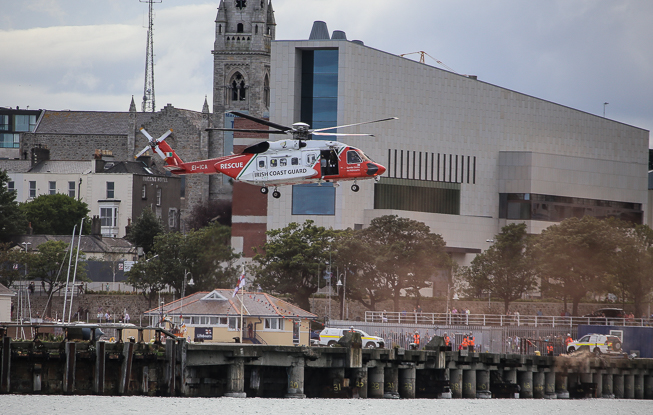 Above and below: The Coastguard Heli 116 landed on the Carlise Pier as part of Dun Laoghaire RNLI's annual Open Day Photo: Afloat.ie
Above and below: The Coastguard Heli 116 landed on the Carlise Pier as part of Dun Laoghaire RNLI's annual Open Day Photo: Afloat.ie
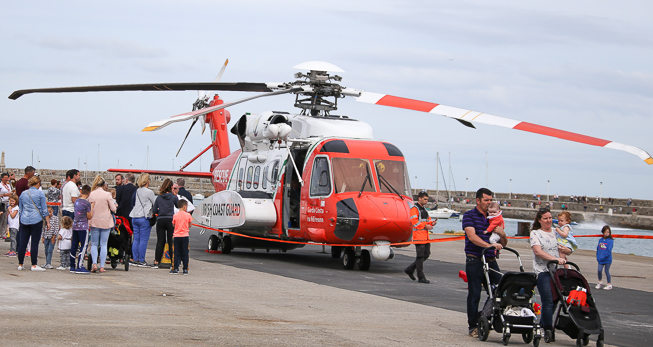
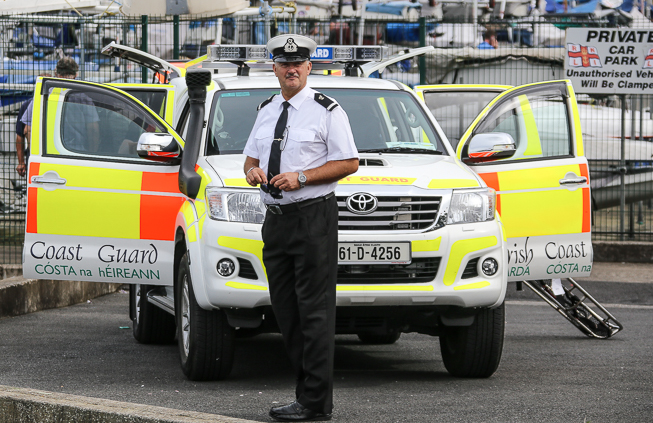 Dun Laoghaire Coast Guard Unit were in attendance Photo: Afloat.ie
Dun Laoghaire Coast Guard Unit were in attendance Photo: Afloat.ie
 Youngsters enjoyed getting onboard Dun Laoghaire's inshore lifeboat at today's Open Day Photo: Afloat.ie
Youngsters enjoyed getting onboard Dun Laoghaire's inshore lifeboat at today's Open Day Photo: Afloat.ie
Nominations Sought for National Marine Gallantry & Meritorious Service Awards 2016
Department of Transport, Tourism & Sport is inviting nominations in respect of the National Marine Gallantry and Meritorious Service Awards 2016. The purpose of this awards scheme is to recognise outstanding acts of courage, heroism, skill and initiative in the context of marine emergency incidents. The scheme also recognises exceptional dedication to duty in the execution of Ireland’s marine emergency response. The Marine Gallantry award is presented in the form of a medal (called the Michael Heffernan Medal for Marine Gallantry, in memory of an individual who lost his life during a marine incident a number of years ago). Three levels of medal may be awarded, based on the level of gallantry involved. The medal is awarded in gold, silver or bronze.
A second award, Marine Meritorious Service Medal, may be awarded where outstanding meritorious service has been provided to, or within the remit of, the Irish Coast Guard. The person must have demonstrated exceptional dedication to duty, coupled with skill and initiative, in the execution of the service being provided.
A Marine Ministerial Letter of Appreciation may be awarded for meritorious service where outstanding dedication to duty over a career of service can be demonstrated, or for an act of particular meritorious dedication, showing skill and initiative, but which is not of an order for receipt of a Meritorious Service Medal.
The National Marine Gallantry and Meritorious Service Awards Committee is chaired by Mr Bryan Dobson of RTE. Members of the Committee include representatives of the following, the Irish Sailing Association, Irish Water Safety, Irish Harbour Masters Association, Bord Iascaigh Mhara, Department of Transport, Tourism and Sport as well as other independent members. The National Marine Gallantry and Meritorious Awards Committee will adjudicate upon the nomination received.
The first award ceremony took place in February 1999 and the awards ceremony was last held on 23rd October 2014. In this round of Awards, nominations may be considered in respect of events occurring during the period 31st August 2014 to 31st August 2016.
Details of the Awards scheme, including nomination form, are available on the Department’s website www.dttas.ie/maritime/english/marine-awards. Completed nomination forms should be submitted by Friday 9th September 2016. The submission should be comprehensive and include all relevant information (e.g. eye-witness statements, official reports, maps, charts, photographs, newspaper cuttings etc.).
2014 Award Recipients
Mr Tony McNamara and Mr. Patrick McNamara - Marine Ministerial Letters of Appreciation for Meritorious Service
Mr Ben Graham, Mr David Grant and Mr. Alexander May - Marine Ministerial Letter of Appreciation for Meritorious Service
Drogheda Coast Guard Unit - Marine Ministerial Letter of Appreciation for Meritorious Service
Mr Michael O’Regan and the crew of the Goleen Coast Guard Unit - Marine Ministerial Letter of Appreciation for Meritorious Service
Mr Jim Griffin – Marine Ministerial Letter of Appreciation for Meritorious Service
Mr Damien Dempsey – Marine Ministerial Letter of Appreciation for Meritorious Service
Mulroy Coast Guard Unit – Michael Heffernan Bronze Medal for Marine Gallantry
Wicklow Lifeboat Assists Whelk Trawler In Morning Callout
#RNLI - Wicklow's all-weather lifeboat Annie Blaker launched at 7.30am yesterday morning (Saturday 3 September) to assist a fishing vessel four miles offshore.
The RNLI lifeboat, under the command of coxswain Nick Keogh, was alongside the stricken vessel 18 minutes after launching.
After a quick assessment, the 12m whelk trawler with three crew was found to have gearbox failure and unable to motor back to port.
Weather conditions in the area at the time saw a sea state slight with rain and fair visibility.
Once a towline was established, the trawler was taken back to Wicklow Harbour, where the volunteer crew secured the fishing vessel safely alongside the south quay by 8.40am.
Youghal RNLI to Name New Inshore Lifeboat Gordon & Phil in Memory of Beloved Parents
A new Atlantic 85 lifeboat for Youghal RNLI is to be officially named Gordon and Phil during a ceremony at the lifeboat station in the Cork seaside resort town at 1pm on Saturday 10 September. The lifeboat which went on service in April was funded through a legacy from the late Gwenda Bull, a native of Brighton in East Sussex, England, who was a supporter of the charity’s volunteers in saving lives at sea.
Prior to her death at the age of 82 in 2013, Gwenda who lived near Shoreham lifeboat station which she visited regularly said in a letter that her family had always appreciated the RNLI: ‘Our family has always admired the wonderful work that the RNLI is doing…I live very near to a station and often visit them, I think you all do a wonderful job.’
Miss Bull who previously funded various equipment for Shoreham RNLI, including a fuel tank storage, the inshore lifeboat slipway, floodlighting, a maroon launcher and an engine for the D class lifeboat, kindly funded the purchase of a new inshore lifeboat, to be named Gordon and Phil in memory of her parents.
Miss Bull was happy for the lifeboat to go on station wherever it would be of most benefit around the coast, so her funds were used to purchase the new B class lifeboat at Youghal Lifeboat station.
Miss Bull’s wish to have a lifeboat named in memory of her parents will be granted when eight-year-old local girl Izzy O’Connell and Albert Muckley, Youghal RNLI Deputy Launching Authority officially name the lifeboat at the station next Saturday
Fergus Hopkins, Youghal RNLI Lifeboat Operations Manager said: ‘This is a very special occasion for our lifeboat station and we are most grateful to the late Gwenda Bull for her generous legacy which has funded this lifeboat, Gordon and Phil. Last year Youghal RNLI launched 12 times and rescued 10 people and we know the new Atlantic 85 lifeboat will continue to assist our volunteer crew as they go about their lifesaving work.’
Youghal RNLI was established in 1857 although Youghal’s first pulling lifeboat was put on service in 1839.
A lifeboat was built for the Harbour Trustees in 1839 by Taylor of Limehouse, the cost of £76 being met by local subscription. A tragedy had occurred Youghal in the previous year, when a hired passage boat carrying 33 people capsized on 18 February 1838, with the resultant loss of 12 lives.
In 1857 a lifeboat house was constructed by the RNLI at Green Hole in Youghal before a new lifeboat house was constructed at the Mall in Youghal in 1876.
This boathouse which had been much altered over 125 years for various classes of lifeboat, was demolished in Autumn 2001 to make way for a new station. A new Atlantic 75 boathouse was completed in September 2002 when Patricia Jennings, was placed on service and remained until April when he was replaced by the new Atlantic 85 lifeboat, Gordon and Phil.
During her 13 years in Youghal, Patricia Jennings launched 175 times with its crews saving nine lives and rescuing 233 people.
Fast, manoeuvrable and reliable, the B class operates in rough weather conditions, capable in daylight up to force seven and at night, to force six winds.
The new lifeboat, an Atlantic 85 is the latest version of the B class, introduced into the fleet in 2005. She is powered by two 115horsepower engines and has a stronger hull and greater top speed than her predecessor. The added radar allows the crew to operate more effectively in poor visibility and she also has VHF direction-finding equipment.
The vessel also has a manually operated self-righting mechanism which combined with inversion-proofed engines keep the lifeboat operational even after capsize. The lifeboat can also be beached in an emergency without causing damage to its engines or steering gear.
The Atlantic 85 carries a full suite of communication and electronic navigation aids, as well as a searchlight, night-vision equipment and flares for night-time operations.
The RNLI is a charity which relies on voluntary contributions and legacies.
Crosshaven RNLI New Inshore Lifeboat To Be Named 'John and Janet'
A new Atlantic 85 lifeboat for Crosshaven RNLI is to be officially named John and Janet during a ceremony at the Cork lifeboat station at 2pm on Sunday 11 September.
The lifeboat which went on service in June this year was funded by an anonymous donor. Afloat.ie's Tom MacSweeney will represent the donor at the naming ceremony and service of dedication and will officially hand the lifeboat into the care of the RNLI.
The lifeboat will be named by Paddy Crowley, son of the late Con, a long serving and much loved helm at Crosshaven RNLI who died suddenly last year.
Last year, Crosshaven RNLI launched 42 times and rescued 50 people. The new lifeboat replaces Miss Betty, the station’s first permanent lifeboat, which was on service in Crosshaven since the station was formally established 14 years ago.
Speaking ahead of next week’s event, Patsy Fegan, Crosshaven RNLI Lifeboat Operations Manager said: ‘The naming ceremony and service of dedication is a very special occasion for our lifeboat station and we are grateful to the anonymous donor who funded our new lifeboat. Since the lifeboat went on service in June, it has launched 17 times and rescued 34 people.’
Fast, manoeuvrable and reliable, the B class operates in rough weather conditions, capable in daylight up to force seven and at night, to force six winds.
The new lifeboat, an Atlantic 85 is the latest version of the B class, introduced into the fleet in 2005. She is powered by two 115horsepower engines and has a stronger hull and greater top speed than her predecessor. The added radar allows the crew to operate more effectively in poor visibility and she also has VHF direction-finding equipment.
The vessel also has a manually operated self-righting mechanism which combined with inversion-proofed engines keep the lifeboat operational even after capsize. The lifeboat can also be beached in an emergency without causing damage to its engines or steering gear.
The Atlantic 85 carries a full suite of communication and electronic navigation aids, as well as a searchlight, night-vision equipment and flares for night-time operations.
The RNLI first established Queenstown Lifeboat Station in 1866, following several wrecks with loss of life off Cork Harbour. However, the first record of a lifeboat in Cork Harbour was as far back as 1825, one year after the founding of the Institution.
Since the closure of Queenstown in 1920, many attempts were made to site a lifeboat in the harbour.
Based on the level of activity in the area, the availability of crew and temporary facilities, a decision was taken to place an Atlantic 21 on evaluation for 12 months in 2000 before the RNLI declared the station a permanent facility in 2001.
Miss Betty, the station’s first permanent lifeboat arrived in 2002 where she remained on service until June this year.
The RNLI is a charity which relies on voluntary contributions and legacies.
Crosshaven RNLI Lifeboat Assist Anglers After Breakdown
Crosshaven RNLI Lifeboat in Cork Harbour was requested to launch yesterday evening at 9.45pm to reports of a speedboat broken down and adrift approximately one km south west of Trabolgan.
In calm conditions with a slight sea,the volunteer crew, under the command of Alan Venner with Ian Venner, Aoife Dinan and Vince Fleming on board headed to the area at best speed.
On arrival, the two anglers onboard the vessel had attempted remedial work with no results. The crew of the lifeboat then established a tow and landed the casualty at Crosshaven boatyard.
The lifeboat returned to station at 11.30pm and is currently being washed down and refuelled by the shore crew before being declared ready for service.
Three Callouts To Help Vessels In Difficulty For Donaghadee Lifeboat
#RNLI - Donaghadee RNLI was called upon three times in the last week to assist vessels which got into difficulties off the coast of North Down.
The first callout was on Thursday 25 August after a yacht with five people aboard struck rocks at the South Briggs buoy in the Copeland Sound.
At the scene, the crew of the all-weather lifeboat Saxon established that no one was injured and the yacht was still seaworthy.
The volunteers and the lifeboat escorted the vessel to a safe harbour for full inspection of the damage to the hull. Conditions were calm.
Saturday 27 August also saw a fine and calm summer’s evening when a RIB with five aboard set off from Scotland for Bangor, but encountered engine failure in the middle of the North Channel as night began to fall.
An emergency call was made to Belfast Coastguard and the lifeboat was requested to respond. The drifting RIB was quickly located eight miles from the Scottish coast. A tow-line was secured and the helpless boat and passengers were in Bangor before last light.
Saxon and crew were called out again on Bank Holiday Monday yesterday to come to the rescue of a small fishing boat with one person aboard.
The eight-metre vessel suffered engine failure and began dragging its anchor in choppy conditions near rocks at Burial Island off Ballyhalbert.
The boat was towed to Portavogie for repairs by another vessel and the lifeboat escorted the pair safely to harbour.


























